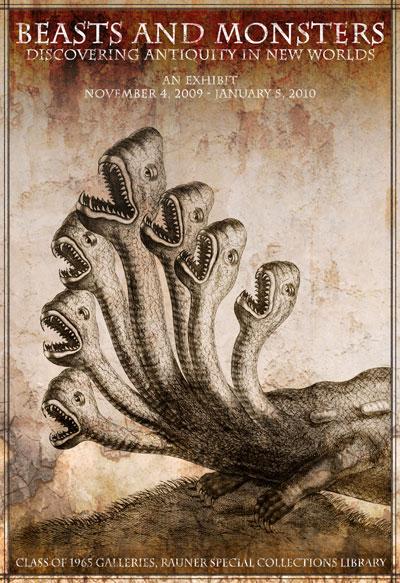Beasts and Monsters: Discovering Antiquity in New Worlds
Educated from classical texts such as Pliny’s Natural History, early explorers and settlers found in the New World many of the creatures and peoples described in antiquity as residing on the edges of the world. From unicorns to hydras to fantastic peoples, expectations were met as Europeans entered new lands.
The exhibition was curated by Pauline M. Gonzales, graduate student in Comparative Literature, and Jay Satterfield, Special Collections Librarian, and was on display in the Class of 1965 Galleries from November 4, 2009 to January 5, 2010.
You may download a small, 8x10 version of the poster: Beasts and Monsters (1.5 MB) You may also download a handlist of the items in this exhibition: Beasts Monsters.

Materials Included in the Exhibition
Case 1: Ancient Peoples Found
As explorers set out from Europe, their existing knowledge of the old world shaped their perceptions of what they saw in the new one. Classical texts, like Pliny's Natural History, provided descriptions of the known world, and formed a collective framework of ideas and concepts. Explorers, cartographers, and settlers alike, informed by their preconceived notions found the peoples and animals that had been documented in antiquity. Thus, the ideas of fabled peoples and animals that the European peoples were born into set up expectations of what should and would be found in the new world.
- Hartman Schedel. Liber cronicarum [Nuremberg Chronicle]. Nuremberg: Anton Koberger, 1493. Incunabula 112 (3 copies)
- Pictured here are many of the fabulous races of humans that Pliny the Elder described as inhabiting the edges of the world. News of Columbus’s discoveries did not reach Nuremberg in time to be included in this chronicle of the world.
- Pliny, the Elder. History of the World. London: A. Islip, 1601. Rare Book QH41 .P72 1601 t.1-2
- Theodor de Bry. Collectio navigationum in Indiam occidentalem. Vol. 3. Frankfurt: Theodor de Bry, 1611. Val H801 B84c
- Richard Hakluyt. The Prinicpal Navigations…. London: George Bishop, 1589. Val G12 H127pa
- Sir Walter Raliegh “discovered” Amazon women in his voyages, as described here and pictured by Theodor de Bry next to a Blemmyes in South America.
Case 2: Beasts and Monsters Documented
Even the scientific description of animals treated the creatures of antiquity as contemporary, authentic creatures. The scientific discourses of the time, natural history and cartography, documented animals from both classical texts and accounts of the modern-day explorations without distinguishing between the two. The ways we approach empirical evidence now in the twenty-first century, by questioning sources and evidence, were not the same in the seventeenth or eighteenth centuries. Zoologist Konrad Gesner did not doubt the validity of these fantastic creatures; they existed because, for the people of that era, they had always existed.
- Konrad Gesner. Historiae animalium. Vol. 1. Tiguri, C. Froschoverus, 1551-58. Rare Book QL41 .G37 v.1 -4
- Gesner painstakingly described all of the known creatures in the world. Here, he carefully distinguishes the “known” sphinx from the one described in legend—making the “real” one even more believable.
- Konrad Gesner. Icones animalium. Tiguri, C. Froschoverus, 1560. Rare Book QL41 .G372
- Harry Potter fans can rejoice (or shudder in fear) to learn that the Basalisc was a well known animal in the 16th century.
- Abraham Ortelius. Theatrvm orbis terrarum. Antverpiae: Plantiniana, 1592. Rare Book G1006 .T5 1570
- The seas surrounding Iceland, known only to whalers, were described as a haven for animals long since cast out of Europe’s navigable waters.
Case 3: Beasts and Monsters Observed
Unicorns, griffins, and hydras were more than just imaginary beasts for the early explorers and settlers. They inhabited the edges of the world and were verified by eyewitness accounts and, in the case of the hydra, by physical evidence. First-hand accounts and tangible samples "proved" the existence of the creatures.
The depiction of the griffin is a curious one. Looking up at the Spanish Conquistador, amidst the violence of the scene, the griffin by be allegorically representing the guardian of the gold. At the same time, since so many new creatures had been documented, in addition to those described in antiquity, it may very well be the case that the griffin, too, was thought to be real.
- John Ogilby. America. London: John Ogilby, 1671. McGregor 129
- The calmly factual description of Unicorns roaming the woods of the New York Canadian border, including feeding and mating habits, could hardly be doubted by Europeans learning of a new world filled with other wonders.
- Bartolome de las Casas. Narratio regionum Indicarum per Hispanos qvosdam deuastatarum verisima. Francofvrti: Theodori de Bry, 1598. McGregor 33
- This little griffin inhabiting a world of torture and destruction is the least frightening “monster” depicted by de Bry in his propagandistic illustrations showing the “Black Legend” of the Conquistadors.
- Albertus Seba. Locupletissimi rerum naturalium. Vol 1. Amsterdam, 1734-65. Rare Book QH41 .S4 v.1-4
- Perhaps the most remarkable beast in Rauner’s collections is the depiction of Albertus Seba’s specimen of a seven-headed hydra in his collection of natural wonders. He admits in the text to being doubtful at first, but becoming convinced that the specimen was true to nature. To a European collector reared on the classics, a seven-headed hydra would probably have been less questionable than a duck-billed platypus.